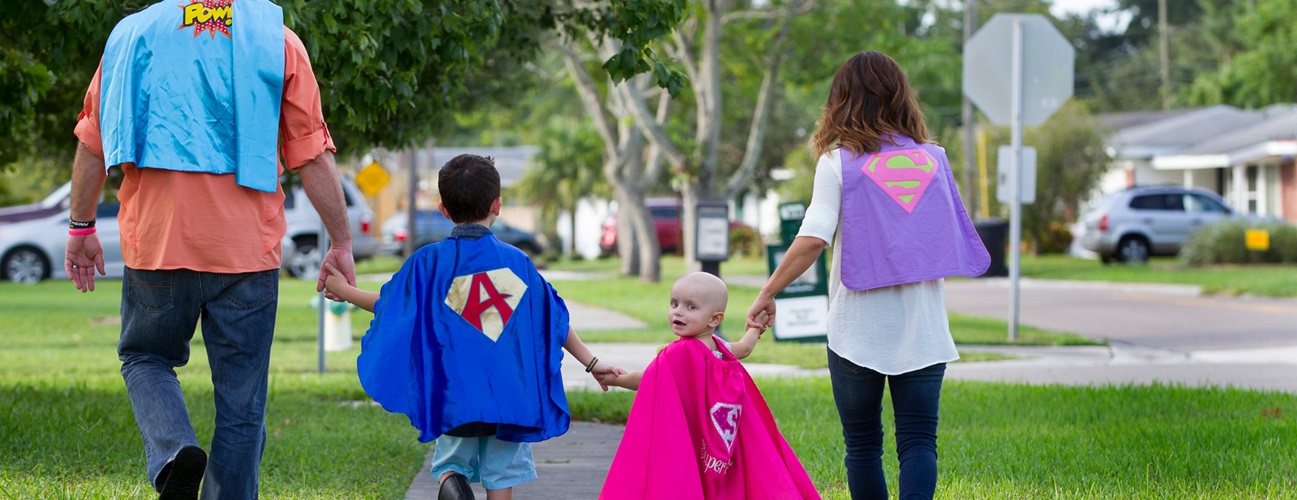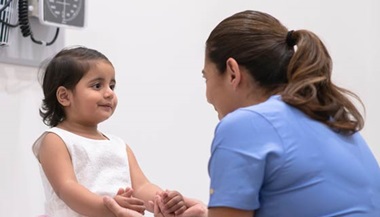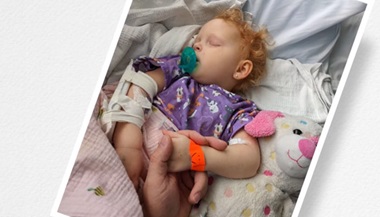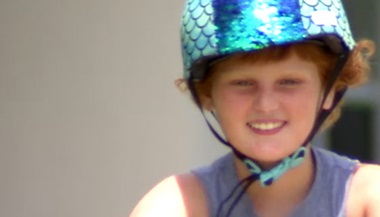Patient Story
Neuroblastoma: Sofia's Story
Patient Story Highlights
- When Sofia developed a black eye that did not go away and began to droop a little, her parents took her to Johns Hopkins All Children’s Hospital, where she was diagnosed with stage 4 high-risk neuroblastoma.
- Sofia has received very aggressive multi-agent treatment for her high-risk neuroblastoma, requiring the collaboration of a team of pediatric cancer specialists.
- The family began working closely with the Johns Hopkins All Children’s Foundation to develop a pediatric cancer research fundraiser to help more children like Sofia.
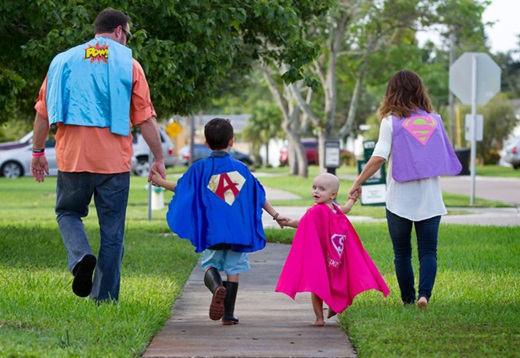
It’s a sign on little Sofia’s hospital room door. It’s a bumper sticker on her family car and it adorns the shirts the family is selling to raise money for pediatric cancer research: “And though she be but little … she is fierce.”
“The quote is very special to us,” explains mom, Catalina (Cat) Anderson. “Sofia is my little firecracker. She is a fighter.”
Sofia’s story began with a black eye on a chubby-cheeked, beautiful little girl. It could have been anything. An unplanned tumble. A wayward Frisbee. But when it stubbornly hung around and the eye began to droop a little, Cat decided to take her 2-year-old daughter to an ophthalmologist, who scheduled a CT scan for several weeks later. That wasn’t soon enough for worried parents Cat and Patrick, who decided the Emergency Center at Johns Hopkins All Children’s Hospital in St. Petersburg, Florida, was a faster option. They walked in and made it clear that they thought a CT was needed right away.
“It was so fast. We found out that day we were dealing with stage 4 high-risk neuroblastoma,” Cat recalls, shaking her head at the memory. “They did an MRI and a bone marrow test. There were a lot of tests, poke after poke. The primary tumor began in her abdomen, there was one in her eye and chin. It was also 100 percent in her bone marrow.”
What Sofia faced next would be daunting for a strong adult. “We began five rounds of intense chemotherapy almost immediately,” Cat recalls. “They did a stem cell rescue, where they pull out her stem cells so they can transplant them back in after the chemo. For each round, we go into the hospital and they put her through two hours of pre-hydration to build her up. Then the chemo can run for 15 minutes, three hours or the full day. Every drug is different.” Sofia has received very aggressive multi-agent treatment for her high-risk neuroblastoma, requiring the collaboration of a team of pediatric cancer specialists.
Sofia received an immunotherapy regimen that has recently been shown in a randomized study performed by the Children’s Oncology Group to increase survival in children with high-risk neuroblastoma. Even so, about half of neuroblastoma patients relapse.
How do you explain cancer to a 2-year-old? “Thank God, she’s never asked,” Cat sighs. “But once, sitting on the sofa, she said, ‘Mommy, where did all my hair go?’ It just ripped me apart. I didn’t know what to say. Finally, I said, ‘Oh honey, it’s going to grow back.’ I just couldn’t get over how quickly it disappeared. It was hard to watch.”
“I’ve gotten brave lately so I’ve been doing some research,” says Patrick. “Neuroblastoma cases are a 50-50 shot, but in kids under 18 months, there’s a 90 percent survival rate. Sofia was diagnosed at 28 months—so it’s a fine line. The chemo melted the tumors, now the disease is still in the bone marrow. It’s a good sign if the tumors respond to chemo. She had the stem cell rescue, but her bone marrow isn’t 100 percent free yet.” Radiation is next, then immunotherapy and then Sofia begins a clinical trial called DFMO that has just become available at All Children’s. They have many months to go in their fight.
Given as a pill rather than an infusion or injection, the new drug is being studied as a new way to prevent reoccurrence of neuroblastoma that is in remission.
The nationwide trial of this investigational drug is operated through a pediatric cancer consortium. The goal is to provide maintenance therapy designed to sustain a remission.
“The next four to six months are the most important,” Patrick explains. “We’ve done so much in the first seven months--but we’re barely halfway there. It hit me hard recently. We’re exhausted, and we are seeing kids who are going through the same thing and they are not having a positive outcome. What if something happens? It constantly nags at you. You stay positive, but we’re human.”
They do their best to find a silver lining while waiting. Sofia’s 6-year-old brother, Aiden, has a best friend who went through chemo for acute lymphocytic leukemia at All Children’s when he was 3 years old. “That was the first time we encountered childhood cancer,” says Cat. “When you don’t know … you don’t know what to do. Now, we are going to get the word out there. We want people to know that this disease exists. If this can happen to Sofia, then we’re going to help raise awareness, help raise funds for the hospital – for another family or for research. This will be our calling.”
The Andersons are working closely with the Johns Hopkins All Children’s Foundation to develop a pediatric cancer research fundraiser. They’ve also become involved with Because of Ezra, a foundation created by the parents of Ezra Matthews, who lost his battle with neuroblastoma at age 3. Because of Ezra supports organizations like the Neuroblastoma and Medulloblastoma Translational Research Consortium) to help develop therapies like DFMO.
“Sofia will start the DFMO trial as soon as she has completed the immunotherapy—early next year,” Cat explains. “We are so excited, because we know this drug has helped extend life for children with neuroblastoma.”
Meanwhile, Aiden stands by patiently, offering support and learning a lot more about cancer than a 6 year old should. “Aiden is her everything. We’ve gotten a lot of great books that talk about cancer, so he knows. We pray every night, and we pray for all the kids on 7 South,” Cat says, speaking of the inpatient hematology-oncology unit at All Children’s Hospital.
They keep each other close, and they keep it positive. She is fierce. They each have superhero capes and on Sofia’s good days the four Andersons fly across the front yard together to show their combined strength. For though she be but little … this family is fierce.

